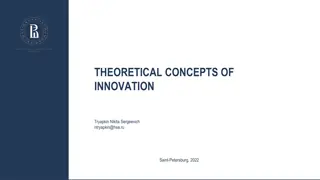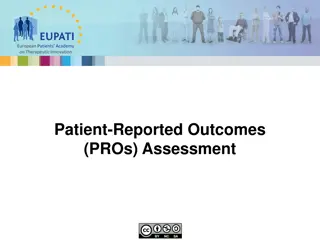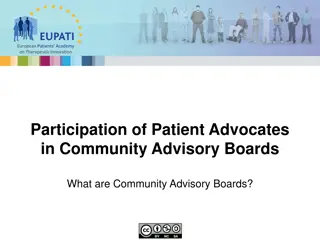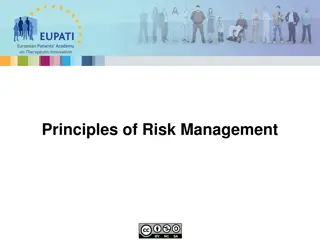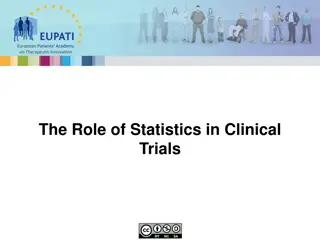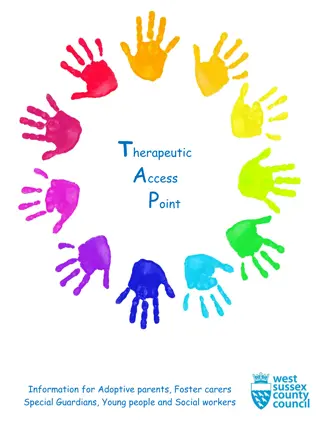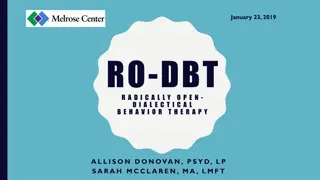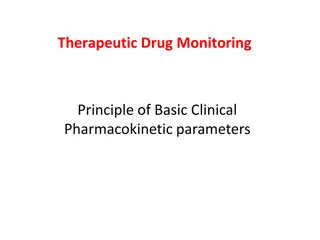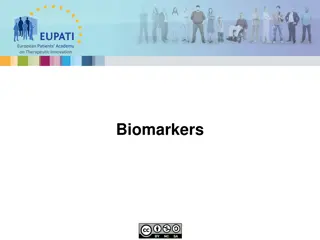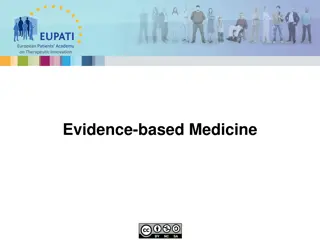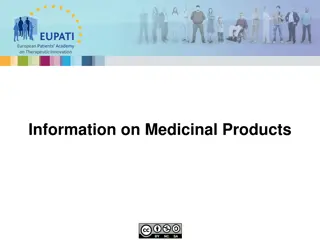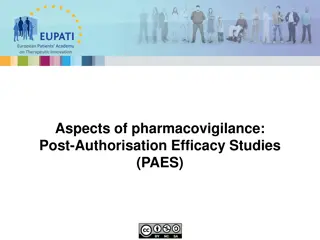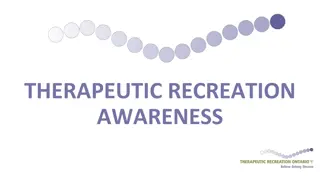Understanding Non-Clinical Development in Therapeutic Innovation
The European Patients Academy on Therapeutic Innovation focuses on the non-clinical development phase of medicine, delving into efficacy assessment, safety evaluation, and manufacturing process considerations. Non-clinical studies are essential for decision-making in clinical trials, marketing applications, and post-marketing studies, aiding in determining human doses and monitoring safety. Various activities during non-clinical development, such as patent registration and synthesis of medicinal products, are crucial for advancing towards clinical testing.
- Therapeutic Innovation
- Non-Clinical Development
- European Patients Academy
- Drug Development
- Pharmacology
Download Presentation

Please find below an Image/Link to download the presentation.
The content on the website is provided AS IS for your information and personal use only. It may not be sold, licensed, or shared on other websites without obtaining consent from the author. Download presentation by click this link. If you encounter any issues during the download, it is possible that the publisher has removed the file from their server.
E N D
Presentation Transcript
European Patients Academy on Therapeutic Innovation Non-clinical development
Objectives of non-clinical development European Patients Academy on Therapeutic Innovation Once a lead molecule (candidate compound) is identified, non-clinical development begins. Non-clinical studies seek to answer the following questions: Does it work? (Efficacy assessment) How can it be delivered and how does the body react? (ADME profiling) Is it safe? (Toxicology/safety, pharmacology assessment) Is the manufacturing process viable and controllable? (CMC activities) Non-clinical development studies and activities continue throughout the life-cycle of the product. 2
Non-clinical developement definition and background European Patients Academy on Therapeutic Innovation The non-clinical development of a medicine is complex and regulatory-driven. The non-clinical development phase primarily aims to identify which candidate compound has the greatest probability of success assess its safety, and build a solid scientific foundation before transition to the clinical development phase, i.e. Phase I (first-in-human) 3
Background activities during non- clinical development European Patients Academy on Therapeutic Innovation During the non-clinical development phase: the intellectual property rights of the candidate compound are registered (patented), and availability of the medicinal product for clinical trials is prepared - synthesis and production of an appropriate amount of medicine for pre-clinical and clinical testing
Why are non-clinical studies needed? European Patients Academy on Therapeutic Innovation Information obtained in non-clinical studies is needed in specific situations for decisions: on clinical trials, on marketing authorization applications, and on post-marketing or monitoring studies. Non-clinical information is also used to determine first-in-human doses of the compound (based on pharmacology and toxicology data) in clinical studies specific on heart function, and insafety monitoring in different systems (liver, central nervous system, renal, etc.) 5
European Patients Academy on Therapeutic Innovation
Types of non-clinical studies (1) European Patients Academy on Therapeutic Innovation In-vitro (Latin for within the glass ) performing a procedure in a controlled environment outside of a living organism; for example, using hepatocyte cultures (cells from the liver) for metabolism studies. In-vivo(Latin for within the living ) experimentation using a whole, living organism as opposed to tissues or cells; for example, in animals or plants. In-silico an expression meaning performed on computer or via computer simulation ; for example, predicting the toxicology profile of a product using its chemical structure with data-based approaches. 7
Types of non-clinical studies (2) European Patients Academy on Therapeutic Innovation In vivo studies (e.g. Animal models) Pharmacodynamics (effects of medicine on organism) Pharmacokinetics (effects of organism on medicine) Toxicity (toxicology) Effects on pregnancy and fertility Carcinogenicity In vitro studies (e.g. Cell lines of a tumor) Carcinogenicity 8
Types of non-clinical studies (3) European Patients Academy on Therapeutic Innovation In Silico (e.g. Computer models) Pharmacogenomics Effects on biomarkers Development of the compound 9
Types of non-clinical studies (4) European Patients Academy on Therapeutic Innovation Pharmacodynamics studies Aim to study how the medicine acts on the body (mode of action (MOA)). Includes gathering information on the pharmacology of the medicine (the study of specific effects on organs, for instance the heart). Pharmacokinetic studies Aim to study the effects of the body on the medicine ADME: A (absorption), D (distribution), M (metabolism), E (excretion) Toxicokinetics of the medicine is the product toxic? 10
Types of non-clinical studies (4) European Patients Academy on Therapeutic Innovation Toxicology studies aim to address the toxicity of the compound in different scenarios: Single-dose toxicity Repeated-dose toxicity Genotoxicity (will the product alter the genetic profile, interfering with DNA or chromosomes?) Carcinogenicity (will the product cause cancer?) Development and reproductive toxicity (DART) 11
Development of the compound for its use in development (1) European Patients Academy on Therapeutic Innovation Before non-clinical studies can begin, an adequate amount of the active ingredient (AI) must be produced. Non-clinical studies usually require quantities of the AI in milligrams or grams; later stages of the development process will require a scale-up process to produce kilograms of the AI In order for studies to meet Good Laboratory Practice (GLP) guidelines, the batches of AI must be qualified and produced according to Good Manufacturing Practice (GMP) guidelines. Chemistry, Manufacturing, Control (CMC) are key aspects during non-clinical development. 12
Key CMC steps during non-clinical development European Patients Academy on Therapeutic Innovation Formulation for non-clinical development studies Determining the dosing system and method of application of the active ingredient based on product properties and type of animal model. Detailed physico-chemical characterisation Stability testing and impurity analysis Development and validation of methods to quantify the active substance in body fluids (e.g. blood, plasma, urine) in pharmacokinetic and toxicokinetic studies Development of a prototype for the clinical formulation 13
Non-clinical outcomes that can halt development European Patients Academy on Therapeutic Innovation Discovery of target organ toxicity For example, if a compound is hepatotoxic (toxic for the liver) in an animal Identification of poor pharmacokinetic properties For example, if a product is poorly absorbed, if it accumulates, or if it generates toxic metabolites. ADME studies are performed to optimize selection of successful product candidates 14
Use of animals in medicines research & development (1) European Patients Academy on Therapeutic Innovation On ethical grounds, the Declaration of Helsinki states the acceptability of using animals as models of risk assessment for man when these models can mimic human diseases. Questions that must be addressed: How relevant are non-clinical (animal) models for the human situation? Were the non-clinical signs and pathologies sufficiently studied within the context of the proposed human use of the novel medicine? 15
Use of animals in medicines research & development (2) European Patients Academy on Therapeutic Innovation How to align expectations from animal information to the information provided by clinical studies in healthy volunteers and patients? Can alternative tests be used? Further resources regarding the importance of animal testing: http://www.animalresearchcures.org/ http://www.animalethics.org.au/legislation/international Experience of patients: http://www.smh.com.au/world/i-would- have-been-dead-at-nine-caterina-simonsen-in-hospital-after- backlash-over-defence-of-animal-testing-20131230-hv75n.html 16
Selecting the appropriate animal model (1) European Patients Academy on Therapeutic Innovation The selection process of an animal species is based on the similarities between the animal species and humans in aspects such as: pharmacodynamics (safety pharmacology), pharmacokinetics, and physiology and pathophysiology of the species compared: - Healthy animals can be used - As well as specific animal disease models 17
Selecting the appropriate animal model (2) European Patients Academy on Therapeutic Innovation Some examples of animal models include: rat (osteoporosis, inflammatory diseases, diabetes, obesity, cardiovascular dysfunctions, neurodegenerative diseases, cancers), monkey (osteoporosis, inflammatory diseases), pig (cardiovascular dysfunctions such as hypertension), and mouse (cancers and some genetic diseases) 18
Extent of non-clinical testing European Patients Academy on Therapeutic Innovation The extent and scope of the non-clinical development programme before, during and after clinical trials is determined according to the following factors: type of medicinal product, type and severity of the disease, population intended to treat, clinical trial phase (Phase I, II, III and post-marketing Phase IV), and anticipated dose and duration of the treatment duration in humans. 19
Toxicity studies required before clinical testing (1) European Patients Academy on Therapeutic Innovation The table on the following slide shows the standard non- clinical information needed before clinical testing (Phase I trials) can begin. The duration of repeated dose toxicity studies depends on the duration of the clinical trial. 20
Toxicity studies required before clinical testing (2) European Patients Academy on Therapeutic Innovation Type of study Aim of study Assessing effects on cardiovascular, respiratory, and central nervous systems (CNS). In vivo and/or in vitro studies, assessing mode of action/effects of candidate compound on the target. Data gathered during in vitro studies on metabolic and blood protein binding data for animals and humans. Systemic exposure data from toxicology studies. Single-dose toxicity studies in two mammalian species but can be completed during studies that define a maximum tolerated dose in the species used for toxicity testing. Vary in length according to duration, therapeutic indication and scope of the proposed clinical programme. Minimum duration for two weeks in two species (one of which is not a rodent). For instance, investigation into phototoxicity (causing a reaction of the skin when exposed to light) Safety pharmacology core studies Primary pharmacodynamics studies Pharmacokinetics and toxicokinetics studies Acute toxicity studies Repeated-dose toxicity studies Other studies of concern
European Patients Academy on Therapeutic Innovation
Types of toxicity studies (1) European Patients Academy on Therapeutic Innovation Local tolerance studies Genotoxicity studies: Assessment of gene mutation Assessment for chromosomal damage in mammalian systems If positive findings are observed in genotoxicity tests, additional testing must be considered. 23
Type of toxicity studies (1) European Patients Academy on Therapeutic Innovation Carcinogenicity studies For medicines indicated for serious diseases in adults or paediatric patients, carcinogenicity testing may be concluded post-approval based on the assumption that early access to the medicines for patients outweighs the possible risk, but the sooner these can be carried out the better. Reproduction toxicity studies 24
How to choose the first-in-human dose (1) European Patients Academy on Therapeutic Innovation Some important factors to consider when the first-in- human dose is established include: All relevant nonclinical data - pharmacological dose response studies, - pharmacological/toxicological profile, and - pharmacokinetics studies Particular aspects of the candidate compound, and Clinical Study design 25
How to choose the first-in-human dose (2) European Patients Academy on Therapeutic Innovation The No Observed Adverse Effect Level (NOAEL) is most important NOAEL level is the level of exposure at which there is no significant increase in the frequency or severity of any adverse effects. In the case of many biotechnology-derived medicines (biological medicines), and when risk factors have been identified, the first human dose is established using the Minimal-Anticipated-Biological-Effect-Level (MABEL). 26



